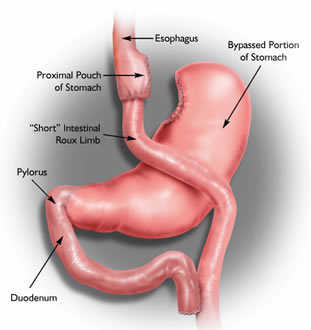Weight-Loss Options
Sleeve Gastrectomy
During the gastric sleeve surgery, a long, narrow, vertical pouch (approximately 2 to 3 ounces) is created by stapling and removing 85% of the stomach and restricting the volume of food that can be eaten.

Laparoscopic Roux-en-Y Gastric Bypass

Gastric bypass surgery makes the stomach smaller and allows food to bypass part of the small intestine. You will feel full more quickly than when your stomach was its original size, which reduces the amount of food you eat and thus the calories consumed. Bypassing part of the intestine also results in fewer calories being absorbed. This leads to weight loss. The most common gastric bypass surgery is a laparoscopic Roux-en-Y gastric bypass.
In a Roux-en-Y gastric bypass, the stomach is made smaller by creating a small pouch at the top of the stomach using surgical staples. The smaller stomach is connected directly to the middle portion of the small intestine (jejunum), bypassing the rest of the stomach and the upper portion of the small intestine (duodenum). This procedure can be done by making a small incision and using small instruments and a camera to guide the surgery (laparoscopic approach).
